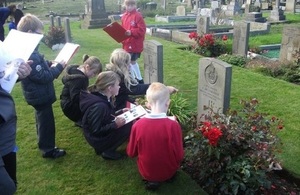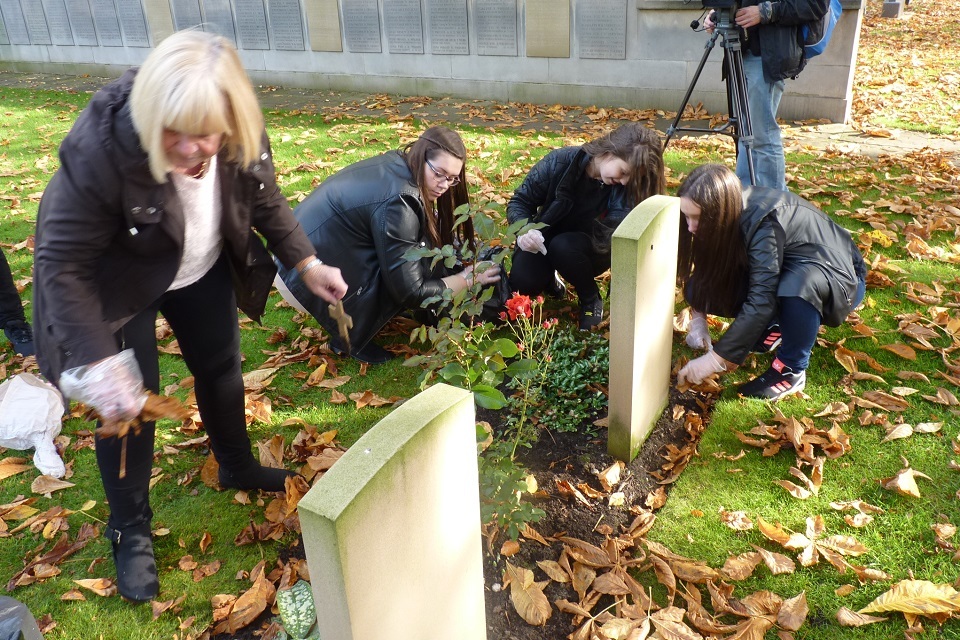Greg Clark: remember UK war graves too
Ahead of Armistice Day, Greg Clark is launching ‘The Living Memory Project’ to remind people of the UK's 300,000 war graves and memorials.

Children in Newcastle tidying war graves
Many of these memorials lie in forgotten corners of graveyards; the Living Memory initiative is designed to aid their rediscovery.
Communities Secretary Greg Clark said:
This year, of course, we’ve continued to mark the First World War’s centenary with a focus on the battlefields of Northern France, Belgium and Turkey. But we should take time to remember the brave men buried and commemorated here in the UK too.
We owe our gratitude to those men, from across the Commonwealth as well as from the British Isles, who made the ultimate sacrifice during the First and Second World Wars.
Paying respects at the war graves of Belgium or France is a life-changing experience, but the final resting places and memorials of thousands of brave men can also be found, not far from your home, in 13,000 locations across the British Isles.
The Living Memory Project is a fitting way to pay tribute to that sacrifice and to learn about our shared history. I’d encourage people to get involved, and discover how they can pay their own tribute.
The Living Memory Project, part-funded by the government, is working with the Commonwealth War Graves Commission (CWGC) and 36 local groups around the country to create remembrance events at local war memorials.

Children in Manchester tidying war graves
Thirty-six groups will work with the CWGC to re-discover war graves, pay respect to the war dead, and share their research with the wider community.
“We should make a positive decision to remember these brave people,” said Mr Clark. “They may have died long before we were born, but they died that we could be free. Their sacrifice should inspire all of us.”
The initiative will continue long after this fortnight of activity, with all communities urged to remember these hidden war heroes annually – creating a thread of memory and shared history long into the future.
CWGC Director of External Relations, Colin Kerr, said:
The Commonwealth War Graves Commission’s work overseas is well known, but here in the United Kingdom there is little awareness of the graves to be found in a staggering 13,000 locations, that commemorate over 300,000 Commonwealth dead of the 2 world wars.
We believe that this is wrong, and through the Living Memory Project aim to reconnect the British public to the commemorative heritage on their doorstep.
With the support of DCLG, the Living Memory Pilot will encourage more people to discover and visit CWGC war grave sites in the British Isles, to remember the war dead in those places from the First and Second World Wars and to share and raise awareness of these 300,000 commemorations with their wider communities.
The aim is to roll the programme out nationwide in 2016 as part of the commemorations of the 100th anniversary of the Somme campaign.
The project has been devised in partnership with community engagement specialists, Big Ideas Company.
Chief Executive Virginia Crompton said:
We are proud to be contributing to such a meaningful project supporting people across the UK to discover their local war graves.
Further information
At a pre-launch gathering in September at Seaford Cemetery in Sussex Jamaican-born poet, Valerie Bloom, read her specially composed poem, Nineteen, in memory of the 19 members of the British West Indies Regiment who are buried there.
Here, a hundred years from home,
A simple headstone tells our story.
In the corner of this foreign field,
Where we’re waiting still, for glory.
The men, all volunteers, contracted pneumonia and mumps within weeks of arriving in the British Isles and died during the winter of 1915 to 1916. To accompany the poem, Valerie has written suggestions to help others to write remembrance poems for themselves.
The Commonwealth War Graves Commission
The Commission maintains the graves of the 1.7 million Commonwealth servicemen and women who died during the 2 world wars. It also holds and updates an extensive and accessible records archive.
The Commission operates in over 23,000 locations in 154 countries across all continents except for Antarctica.
The Work of the CWGC in the UK
More than 300,000 Commonwealth servicemen and women who died in the 2 world wars are commemorated in the United Kingdom – their graves can be found at almost 13,000 locations.
The majority of those commemorated in the UK are the men and women who died at home in military hospitals. Others may have died in operations over the United Kingdom, in training accidents or air raids or at sea in coastal waters, their bodies washed ashore.
Over 100,000 missing naval, merchant navy and air forces casualties are commemorated on the Commission’s great memorials to the missing at Chatham, Plymouth, Portsmouth, Tower Hill and Runnymede.
The graves are cared for either directly by the Commission’s staff – managed from operations at the UK Office in Leamington Spa – or through contracts and arrangements with individuals, contractors and burial and church authorities.
The Living Memory Pilot Project 2015 is running in Reading, Bristol, Belfast, London, Perth, Manchester and Seaford in Sussex.
Office address and general enquiries
2 Marsham StreetLondon
SW1P 4DF
Contact form https://www.gov.uk/gui...
General enquiries: please use this number if you are a member of the public 030 3444 0000
If your enquiry is related to COVID-19 please check our guidance page first before you contact us - https://www.gov.uk/guidance/coronavirus-covid-19-guidance-for-local-government.
If you still need to contact us please use the contact form above to get in touch, because of coronavirus (COVID-19). If you send it by post it will not receive a reply within normal timescale.
Media enquiries
Email newsdesk@communities.gov.uk
Please use this number if you are a journalist wishing to speak to Press Office 0303 444 1209